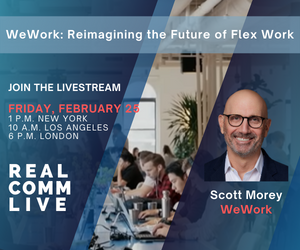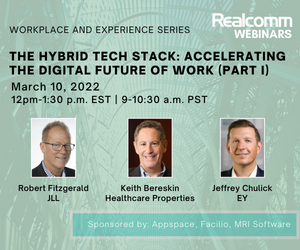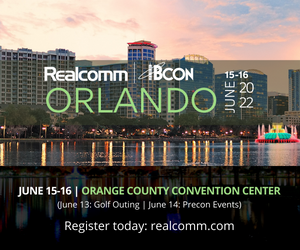Office, Where Innovation Works

As general acceptance of the “workplace” grew, the changes to our vocabulary of “I’m in the office,” “I’m going to the office,” and “How late are you staying at work” became part of the norm. The workplaces that we built became a part of our daily routines and even became a second home for some.
When changes to our environment happened, these buildings adapted with us. Buildings, in general, became smarter, more efficient, complex, but most importantly, they welcomed the masses that would occupy them daily. The complexity grew so much that we found ourselves in the world of smart connected buildings, providing insurmountable amounts of services to meet the ever-changing landscape of the workplace.
For the past couple of years, our world has faced challenges that have disrupted the way we operate. Whether these disruptions were influenced by technological changes, political challenges, global health advisories, social reform, or simply our continued growth and sophistication as a species, commercial real estate has continued to play a part in our environments. While our industry prepares for emergencies that may force us to empty our buildings, I do not believe we could have predicted that our buildings would be in the state they are in for the time that has now transpired.
When stay-at-home orders were declared, many of us thought that a few weeks at home working remotely would be fun. When those weeks turned to months, we figured out why not use the time to retrofit, enhance and provide upgrades to systems. When those low-hanging projects were completed and our buildings were still at low occupancy, we turned our sights to significant projects. Kilroy's leadership team’s vision was one of addressing the challenges of the pandemic while also looking towards the future needs of our buildings and our tenants. Not only were we looking at ways to mitigate risk, enhance cleaning, provide better air quality, among many others, but we also looked towards the future. What will the world look like in two, five, or ten years? What would be the needs of our tenants? How can we affect positive changes in our environment while still providing the quality services that have made us a market leader?
Needless to say, our Asset Management, Facilities/Engineering, and Construction teams have been extremely busy these past two years. We pride ourselves in our commitment to our environment, positively influencing our communities, and being where innovation works. As we moved forward, these ideas have further shaped our building development and management approach. When we look at the infrastructure of our sites, we want to ensure that we can provide buildings that are both physically and digitally secure, adaptable to the changing environment, sustainable, but above all, meet the requirements of our tenants.
The idea that employees are more productive inside their employers-controlled space can be traced back to the early days of industrialization. As we grew and erected large factories, warehouses, and office buildings to meet the demand of the changing world, the notion that "butts in seats" in the office were essential to the success of any business. Before having steel mills, we had local blacksmiths, and as the notion of professional services grew, we transitioned away from home-based businesses and into curated spaces to conduct operations. As our towns turned into major metropolises, we constructed beautiful buildings to house the growing needs of formal workforces. The workplace transitioned from your dining table to spaces designed and built for the purpose of fostering the growth of enterprise. It also helped that individuals with influence appreciate having their name on the side of these gorgeous brick, stone, and steel buildings to help foster their construction.
If the past two years have taught us anything, employees may not necessarily need the office to effectively do their job. With the ever-connected world, individuals can perform their responsibilities from home, cafés, and even the beach with relative ease. In many cases, we went back to simpler times when business was conducted from nontraditional locations. Many individuals found benefits to being close to family, their pets, and the comfort of their homes. The dreariness of the cubicle farm was replaced with the delight of rolling out of bed, turning on your computer and no one knowing if you were still in your underwear, or so I have heard from colleagues. Yet as time went by, we found ourselves wanting to return to our offices, our buildings, services, our friends, and colleagues, but not necessarily wanting the constraints of the past. The need to separate personal time from work hours has increased the demand for people to separate those spaces.
In my perspective, the future of office space is a blend of home and office services. Kilroy has achieved this by using technology, creative design, and construction, but above all being innovative. If you look at our properties, you will find design with purpose and technology to help with business needs. You can sit at your desk or step outside into our building grounds and enjoy the sunshine without compromising connectivity. Tenants can engage with local vendors via remote applications to order services. As we build vibrant campuses, tenants can feel the warmth of the space being created with them in mind. The goal of providing home-like offerings and working with our tenants to meet their employee needs is paramount to the success of our properties. The idea of the office being just a shell is long gone. Prior to the pandemic, our industry was already moving towards this blend of home and office. The integration of home comforts with the robust services of purpose-built business space was just accelerated. The idea that you can seamlessly move between your desk at home and your desk at work will be a requirement.
The office will always be part of our life; the question will be how flexible it will be with your lifestyle. I do not believe that we will choose to go back to the idea that "butts in seats" are a requirement for success. Instead, I think we will have the option of where we sit while knowing that our homes and offices will meet our needs. The building workplace environment has always served to bolster collaboration, foster relationships, and mentoring amongst peers. As landlords, we also strive to ensure that connectivity, temperature comfort, indoor air quality, and a myriad of utilities and services are at the fingertips of our tenants. Having that modern purpose-built environment to create synergies is essential to contributing to a company’s competitive advantage. As a building owner, developer, and operator, we recognize this is a crucial element to working with our tenants to provide that platform by leveraging our building services that individuals would be unable to obtain while working remotely or from home.
The world is continuously changing, but the beauty of brick, stone, and steel will be going nowhere. Instead, we will need to be more innovative in developing, building, and maintaining these great assets. Through technology, creative design, a sustainable mindset, creative and thoughtful construction, we hope to meet future challenges. We are “Where Innovation Works.”
This Week’s Sponsor
Embracing open software/hardware platforms, Lynxspring develops, manufactures, distributes, and supports the edge-to-enterprise and IoT solutions that create smart buildings, smart equipment, and smart applications. Our technology provides connectivity, control, integration, interoperability, and data access, management, and analytics. Lynxspring’s solutions are deployed in millions of square feet of commercial settings in the United States and internationally. Visit www.lynxspring.com.
Read Next
 5/15/2025
5/15/2025
Tech, Talent and Transformation: 2025 Digie Finalists Announced For 27 years, Realcomm has presented the Digie Awards to acknowledge companies, real estate projects, technologies, and individuals that have advanced the commercial real estate industry through the strategic use of technology, automation, and innovation.
 5/15/2025
5/15/2025
Empowering Space Management with Data-Driven Visualization For effective CRE space management, it’s critical to centralize lease data, maximize rental square footage (RSF), improve energy efficiency and reconfigure spaces to meet changing needs.
 5/8/2025
5/8/2025
The AI-Powered Workplace Evolution: Redefining the Business Landscape In today's rapidly evolving business environment, the fusion of Artificial Intelligence (AI) and Workplace Management is revolutionizing the way organizations approach workspace optimization and operational efficiency.
 3/27/2025
3/27/2025
The Convergence of Edge Computing, Cloud, and AI in Building Automation and Smart Buildings In the built environment, we have seen the convergence of Operational Technology (OT) and Information Technology (IT), later expanding to include Workplace Technologies (WP).








%20(1)%20(1)%20(1).png)





